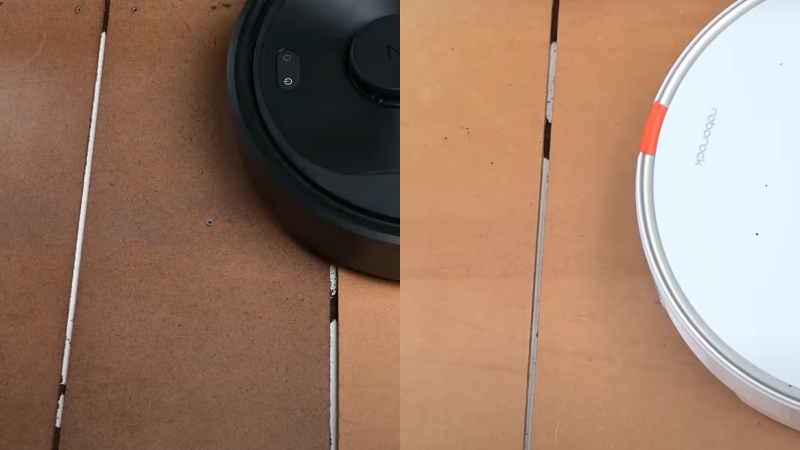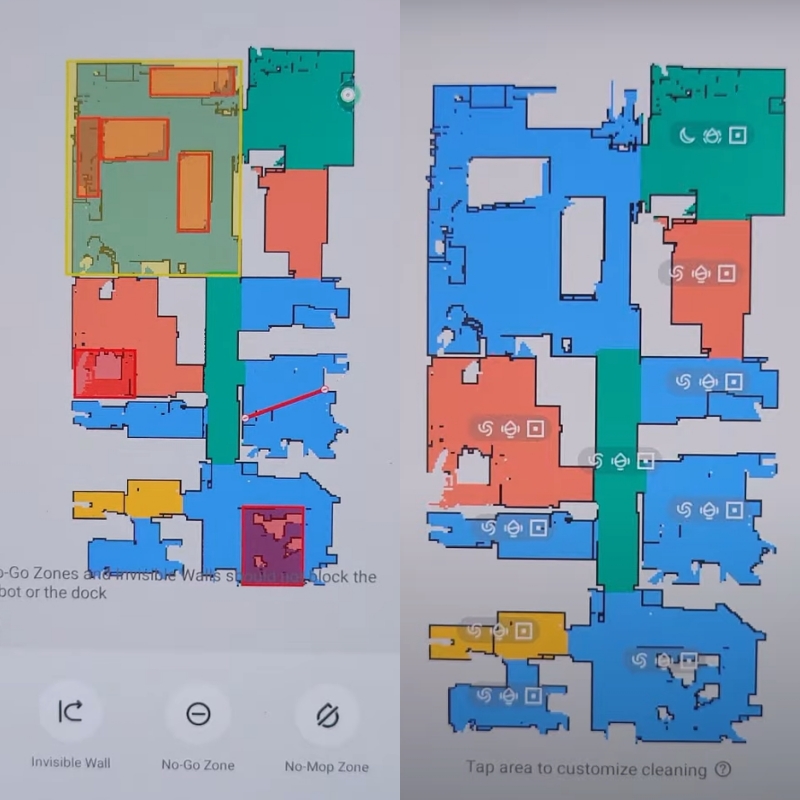When comparing the Roborock Q5 vs S7, the latter model emerges as the superior product. These two have the same navigation technology and similar app connectivity and offer comparable performance. However, the S7 has several upgrades that offer several notable advantages for your daily use.
First and foremost, the Roborock S7 features advanced mopping capabilities, including sonic vibration technology and an adjustable water flow system. Additionally, the S7 boasts enhanced main bush roll design and housing. These things significantly improve its floor cleaning performance compared to the Q5.
The Roborock Q5, in my evaluation, is a solid robot vacuum with great cleaning performance and navigation, outshining many other products in the same price range. Its suction is relatively stronger than the S7, but it is more prone to hair tangling and does not have the mopping function. Yet, if you just need a formidable bot with excellent vacuuming efficiency, the Q5 is definitely the best bang for the bug.
Roborock Q5 Vs S7: Comparison Chart




Roborock Q5 Vs S7: Differences
In the competition of Roborock Q5 vs S7, the Roborock S7 wins with a score of 1-0 against its rival, thanks to its mopping function. The Q5 is a formidable competitor with comparable cleaning performance and efficient navigation and mapping.
Cleaning performance
Tie!
Suction
| Roborock Q5 | Roborock S7 | |
|---|---|---|
| Max airflow (cfm) | ~15 | ~13 |
| Max suction (kPa) | ~0.2 | ~0.08 |
The brand claims that the Roborock Q5 has a suction of 2700Pa, higher than the 2500Pa suction level of the S7 model. The measured result also proves this. The higher suction power can contribute to enhancing the cleaning efficiency of the Q5, which may be better than the S7’s performance.
Carpets
For the carpet cleaning performance, I ran these two bots on medium-pile carpets with the Max power mode and recorded their pick-up efficiency with large debris (using oats and cereals) and small, fine debris (sand and powder). The results show that both the Roborock Q5 and S7 perform pretty well in carpet deep cleaning. Yet, the S7 is relatively better, which can be attributed to the new brush roll design, providing more efficient surface agitation.
| Pick-up Efficiency (%) | Roborock Q5 | Roborock S7 |
|---|---|---|
| Deep cleaning | ~77% | ~79% |
| Large debris | ~70% | ~70% |
| Fine debris | ~48% | ~50% |
Hard floors
Both Roborock S7 and Q5 do an incredible job at cleaning hard floor surfaces, even with fine and large debris. When testing their performance in picking up small and heavier particles like sand and cat litter, their efficiency is comparable, highly scoring 99.7%. The selected suction for the hard-floor cleaning was the Balanced mode.
| Pick-up efficiency (%) | Roborock Q5 | Roborock S7 |
|---|---|---|
| Large debris | ~98% | ~96% |
| Fine debris | ~99.7% | ~99.7% |
Edges and crevices

They clean edges and crevices with decent performance. Their 5-prong side brushes effectively pull the dust in the wall edges into the main cleaning path so that the bots can collect all of them optimally. Besides, with the floating brush housing, the Q5 and S7 provide a better surface seal, leading to improvement in crevice pick-up efficiency, greater than most appliances at the same price range.
Pet hair
| Hair-resistance (%) | Roborock Q5 | Roborock S7 |
|---|---|---|
| 5-inch strands | ~70% | ~74% |
| 10-inch strands | ~20% | ~43% |
They collect 100% of pet hair in my pick-up performance tests. However, in hair-resistance efficiency assessments, there are differences between them. The Roborock S7 has better hair-resistance performance than the Q5 model, especially in the case of long hair strands (10 inches).

Design & Convenience
Tie!
Dimension
These two robot vacuums are similar in shape and dimension, yet the Roborock S7 is a bit heavier than its counterpart. As they have a LiDAR tower on the top, stuck issues can happen it the clearance between the floor and the furniture’s bottoms is insufficient. Their total height, including the LiDAR, is around 4 inches, so they cannot go under furniture with clearance less than 4 inches.
Brush roll system
The Roborock Q5 and S7 boast the same side brushes and main brush housing. However, the Roborock S7 utilizes the all-rubber brush, while the Q5 model uses the combo-brush of rubber and bristle. With the rubber brush, the S7 offers better hair-resistance performance than the Q5.
Nevertheless, the roller of the S7 is compatible with the Q5. It means that I can buy the separate rubber roller of the S7 and insert it into the Q5’s main brush housing to improve the overall cleaning performance of the Q5. Plus, if you don’t need the mopping function, I find this way more cost-efficient than purchasing the brand new S7 since their pick-up efficiency is not too different.

Navigation & Obstacle avoidance
- Navigation & Mapping
Roborock S7 and Q5 both employ LiDAR technology for precise navigation as they map the layout of your home. Their laser LiDAR tower stands out for its exceptional effectiveness in recognizing objects and furniture, surpassing other navigation technologies in the industry. This means they don’t rely on ambient light to perceive their surroundings, allowing them to operate effectively even in dimly lit or dark environments.
Both the Roborock Q5 and S7 impress with their swift mapping capabilities, typically charting your home in just half an hour during their initial runs. Furthermore, the ability to save up to four distinct floor plans provides valuable flexibility, enabling me to select specific rooms and floor levels for cleaning.
I particularly appreciate the wall sensor of these Roborock models because it helps guide the robots along walls without unnecessary collisions. Moreover, their advanced cliff sensors ensure they steer clear of potential stairway hazards, enhancing their safety and reliability.

Obstacle avoidance
Regrettably, both the Roborock S7 and Q5 lack obstacle detection capabilities, which means they struggle to navigate around objects scattered on the floor. If these objects are shorter than the LiDAR tower’s scanning level or too light for the robot’s bumpers to detect, the robots are prone to bumping into them.
During testing, both of them cannot avoid cords, socks, or shoes. Therefore, it’s essential to carefully pick up all items on the floor before using these two Roborock bots. Additionally, it’s worth noting that they won’t avoid pet waste either. If you have pets in your home, and pet waste is a concern, you have to clean the waste yourself; if not, the bots will run over and create a big mess on your floor.

Battery life
The Roborock S7 and Q5 have the same battery capacity, showing that they both can work for 180 minutes on a single charge when in the lowest power mode. When I tested them with Balanced mode, the estimated max runtime was about 100 minutes. Besides, the S7 and Q5 feature a resume function, allowing them to continue cleaning where they left off after sufficiently recharging.
| Roborock S7 | Roborock Q5 | |
|---|---|---|
| Capacity | 5200 mAh | 5200 mAh |
| Battery life | ~ 100-180 minutes | ~ 100-180 minutes |
| Charging time | ~ 6 hours | ~ 6 hours |
Control
Tie!
Physical control
The button controls on the Roborock S7 are quite uniform, with clean/power button and a dock home button. However, the S7 has an additional feature not found on the Q5: the spot clean button.
The spot clean button on the Roborock S7 has dual functions: one is to ask the bot to clean a specific area, and one is known as “Child Lock.” By holding down this button for 3 seconds, the Child Lock mode is activated, disabling all the buttons on the S7 housing. To exit Child Lock mode, simply press and hold the same button for 3 seconds again.
This “Child Lock” feature can also be activated conveniently through the Roborock app. I personally like this feature because it provides an extra layer of control to ensure continuous cleaning sessions without being disturbed by children or pets in the household.
App control
Their smart apps are user-friendly and offer a wide range of capabilities. Both the Roborock S7 and Q5 allow me to map, create, and save multiple floor plans (up to 4 floor levels), which is a handy feature. Within the app, I have the flexibility to customize these maps by labeling, dividing, or merging rooms according to my preferences.
I can also use the app to send these robots to clean specific rooms or zones rather than cleaning the entire house to save the runtime. Furthermore, the apps for both the S7 and Q5 enable me to establish no-go zones and invisible walls, effectively preventing them from entering and getting stuck in cluttered areas.

In addition, scheduling cleaning sessions is a breeze with the app. I can create different cleaning schedules for various rooms, adding a layer of convenience to the process. The apps also provide a detailed cleaning history, allowing me to track when, where, and how long the robots have cleaned. To top it off, I can conveniently control these robots with voice commands using popular voice assistants like Alexa and Google Home.
However, the Roborock Q5 provides a 3D mapping function, which allows the bot to create a more virtual map of my house. Additionally, in 3D mapping, I can add specific pieces of furniture and set the actual flooring material. The S7 does not have 3D mapping, but due to the ability to mop while vacuuming, Roborock S7’s app features the no-mop zone function and moping intensity customization.
Cleaning & Maintenance
Tie!
The Roborock Q5 and S7 have the same dustbin capacity of 470 ml and E11 filters with 95% filtering efficiency. One thing I consider a plus about their filters is that they can be washed with tap or warm water. After washing them, you must let them dry for about 24 hours before inserting them back into the bots.
The Roborock S7 comes equipped with a convenient simultaneous mopping function, supported by a 300 ml water tank. It’s important to monitor the water tank’s levels and top it up as needed to ensure uninterrupted cleaning. Additionally, after each cleaning cycle, you should wash the mopping cloth thoroughly to ensure the robot’s peak performance for the next run.

Both of these robots are compatible with self-empty docks, utilizing disposable dust bags for hassle-free dustbin emptying. Personally, investing in a clean base has been a game-changer for me, as it keeps dust clouds at bay, providing relief for my nose.
Regular maintenance is key. Check their undersides every two weeks to remove any hair strands tangled in the edge brushes, roller bearings, and castor wheels. Also, remember to gently clean their sensors on a regular basis to guarantee optimal performance. These steps ensure that your robotic helpers continue to work efficiently.
Other features
Winner: Roborock S7
Noise levels
| Roborock S7 | Roborock Q5 | |
|---|---|---|
| Working | ~60 – 77 dB | ~62 – 79 dB |
| Self-emptying | N/A | N/A |
The noise levels of these robots fall somewhere in between – they’re not exactly whisper-quiet but also not overly loud or unbearable. The noise they generate tends to change as they move across various types of flooring. Besides, both the Roborock S7 and Q5 come with four distinct power modes, which also result in varying noise levels.
Mopping function

The Roborock S7 left a strong impression on me, primarily due to its ability to simultaneously mop and vacuum. What sets it apart is the innovative sonic mopping technology it employs. This technology vibrates the bot’s mopping pad, allowing it to efficiently tackle stubborn stains and significantly elevate its overall cleaning performance.
Moreover, the Roborock S7 boasts a carpet sensor and VibraRise technology, which enable it to detect carpets and lift the mop slightly before transitioning onto carpeted areas. It’s important to note that the mop is lifted by a mere 5mm, making it best suited for low-pile carpets or rugs.
Thankfully, the S7’s dedicated app offers the flexibility to establish “no mop zones,” a valuable feature if you have carpets with higher pile or shaggier textures. This customization ensures that the S7 adapts to your specific flooring needs.
Quick Rundown of Roborock S7
- Sonic Mopping Technology. Roborock S7 robot vacuum mops with the power of sound, scrubbing up to 3,000 times per minute. Fed by a 300 ml electronic water tank, stains from coffee to mud and more can be cleaned deeply and effectively.
- Intelligent Mop Lifting. S7’s VibraRise mop lifts when a carpet is detected, so you can mop hard floors and vacuum carpets in a single clean. It also raises when cleaning is finished to avoid spreading dirt, and when docked so you can say goodbye to ugly plastic mats and dirty streaks.
- Upgraded Brush System. Multi-directional floating brush keeps the brush closer to the ground for deeper cleaning even on uneven surfaces. Roborock S7’s all-new rubber brush is more durable and resists hair tangling better. It’s perfect for homes with pets.
- Powerful Performance. With 580g mop pressure and 2500PA HyperForce suction, Roborock S7 easily lifts dust and hair from floors and pulls it from deep inside carpets. It is the most powerful and the most convenient robot vacuum Roborock has ever made.
- Ultrasonic Carpet Recognition. Roborock S7 accurately identifies carpets using ultrasonic sound. Once a carpet is recognized, S7 will automictically boost the suction power for a deeper carpet cleaning. You can also choose to have the mop lift to vacuum low-pile carpets, or use No-Mop Zones to prevent it from cleaning medium and high-pile ones. You do not need to worry about wet carpets while cleaning the floor.
Quick Rundown of Roborock Q5
- Note: The robot vacuum will report "charging" when it's connected with the charging dock correctly. Otherwise, the device might not be in charge mode. The dirty charging contacts will cause two charging contacts at bottom of the robot will not well attached to the ones on the charging dock, please clean the charging contacts regularly. Please kindly double confirm if the charging cable and the slot of the dock are well connected. Push the cable head into the slot at bottom of the dock very hard.
- Note: Please notice the robot vacuum condition before buying.
- 【Deeper Cleaning with Powerful 2700Pa Suction】: Roborock Q5 is the upgraded version of S4 Max.With powerful 2700Pa suction, the Roborock Q5 easily picks up pet hair, dust and finer dirts from floors or carpets. When a carpet is detected, it will automatically increase its suction to the maximum for deep cleaning.
- 【Convenient App Control】: Control every element of Q5 through the Roborock app, including viewing the exact vacuuming route, setting cleaning schedules, adjusting the suction power, creating No-Go Zones, Invisible Walls, and much more. All from anywhere you have internet.
- 【Precision Mapping with PreciSense LiDAR】: LiDAR navigation creates accurate maps, and Q5 can save up to 4 maps. Use 3D Mapping to view your home in 3D and add furniture and floor materials to recreate your home virtually.
Product Videos
Related Articles to Roborock S7
- Roborock Q7 Max Vs S7: What Are the Differences Between Them?
- Roborock Q Revo vs S7: Battle of the Cleaning Titans!
- Roborock S7 Vs Roomba I7: Which Will Win The Battle Of Performance?
- Comparing The Roborock S7 Vs iRobot S9: Which Prevails?
- Roborock S7 Vs Roomba S9+: An Honest Review And Detailed Comparison
- Roomba J7+ Vs Roborock S7: An Ultimate Guide
Related Articles to Roborock Q5
- Roborock Q5 Vs Shark AI Ultra: A Head-To-Head Comparison
- Roborock Q5 Vs Q7 Max: An In-Depth Analysis
- Roborock Q5 vs Roomba I3: Clean Homes Powerhouse Face-Off!
- Roborock Q5 Vs Eufy X8: What Is The Difference?
- Roborock Q5 Vs Q7: Which One Is Suitable For Your Need?
- Roomba S9+ Vs Roborock Q5: Which One Should You Get?
- What Is The Difference Between The Roborock Q5 Vs Q5+?
- Roborock E5 Vs Q5 Detailed Comparison Review
References:
- Roborock S7: https://us.roborock.com/products/roborock-s7-robot-vacuum-and-mop
- Roborock Q5: https://us.roborock.com/products/roborock-q5

Richard B. Schmidt is a prominent figure in the vacuum cleaner industry, boasting over 15 years of expertise. Armed with a Robotics Engineering degree from Northeastern University and a Master’s in Consumer Science from Harvard, his unique blend of technical knowledge and consumer insights positions him as a sought-after authority in vacuum cleaner evaluation. Richard’s career began at Dyson, where he contributed to the development of innovative vacuum models. Transitioning to advocacy and reviews, he co-founded the first Vacuum-focused blog in 2008, offering comprehensive analysis and user guides for various vacuum cleaners. In 2020, he founded RoboMop.net, providing ongoing insights through columns and buyer’s guides.
